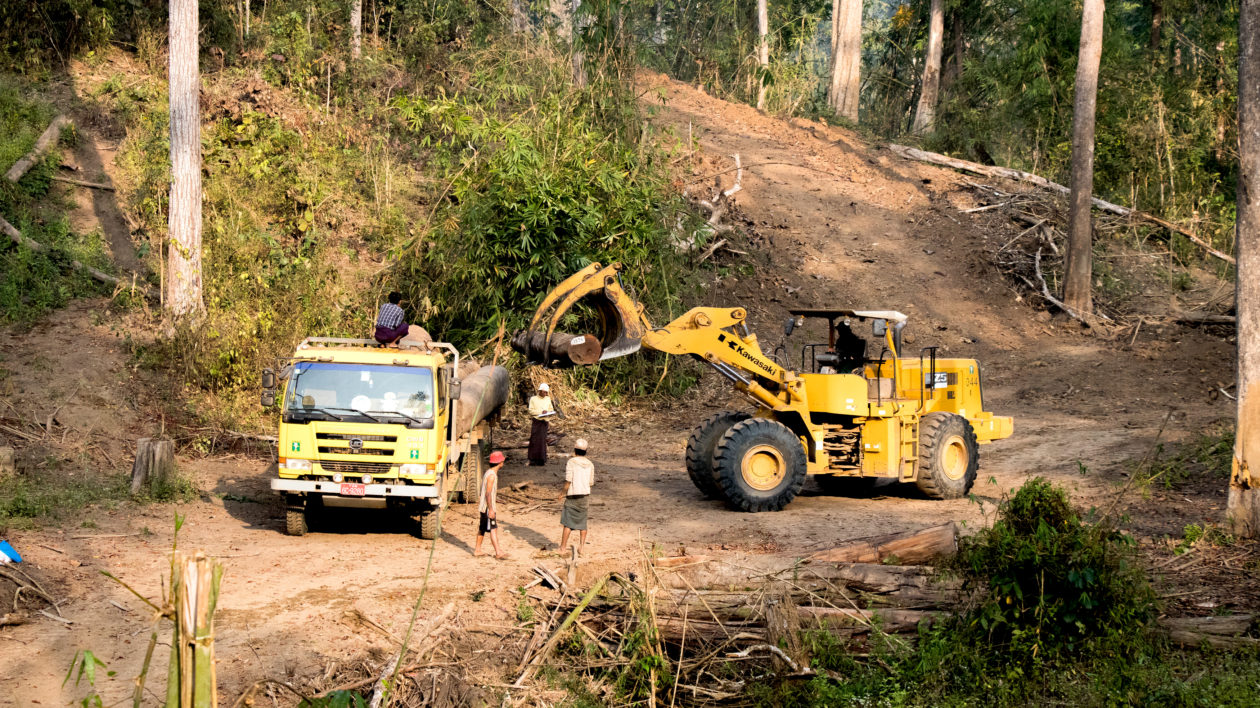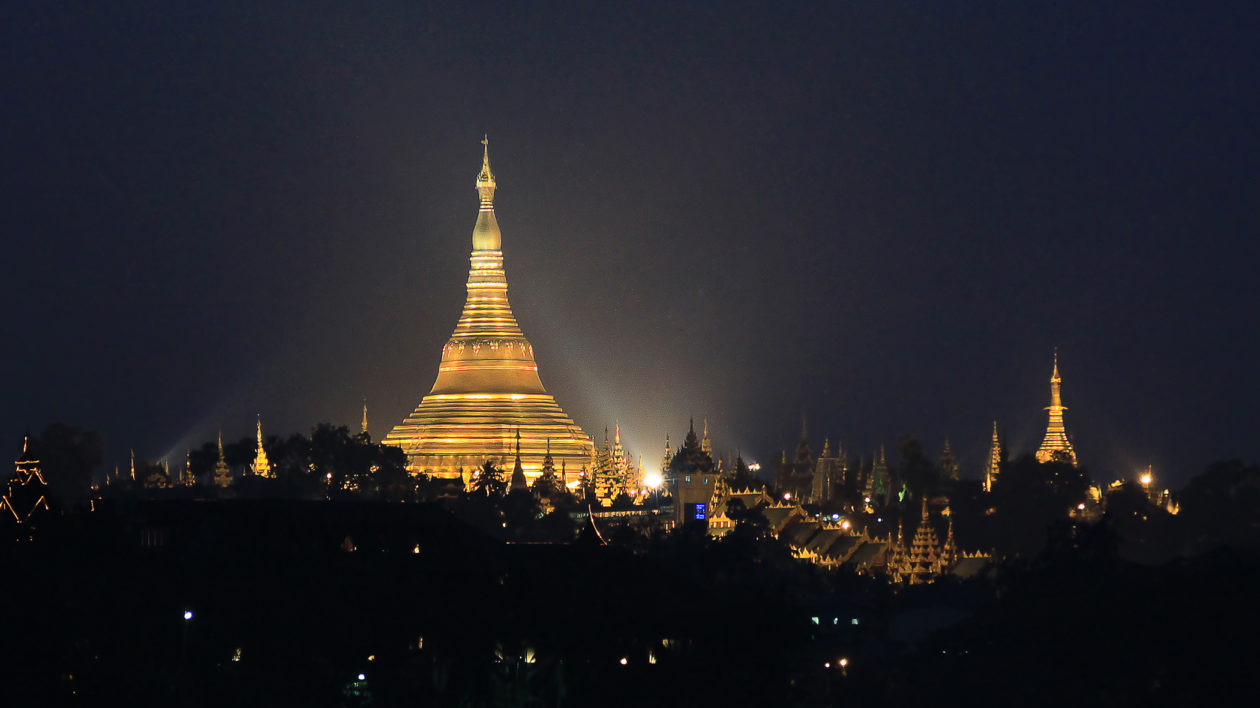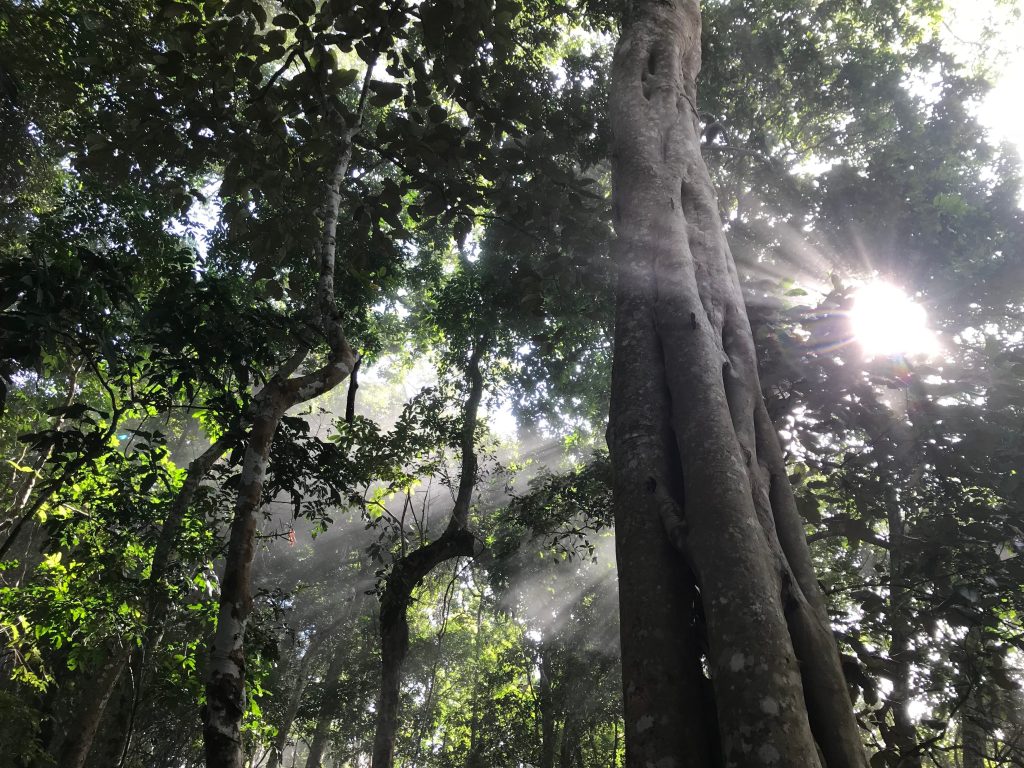This story was reported before the February 2021 military coup in Myanmar. Details within may be outdated.
It’s taken us 10 days to find this place. We left at sunrise, hiking through Myanmar’s Bago Yoma mountains in search of pristine teak forest. After 8 kilometers the forest changed, and we were surrounded by dozens of golden-trunked teak trees, most so large that three of us can’t wrap our arms around them.
Then a sound stops us all in our tracks — the incessant scream of chainsaws. Myanmar’s government recently banned logging in the Bago’s forests, which can only mean one thing… these are illegal loggers. Ahead of me, our guide turns around, looks me in the eye, and draws his thumb across his throat. I don’t need to speak Burmese to understand what that gesture means. We need to leave. Now.
Decades of overharvesting have ravaged Myanmar’s forests, and illegal logging is undermining the government’s efforts to reform forestry practices. But chainsaw-wielding crime syndicates are just part of the problem: A looming energy crisis is forcing Myanmar’s citizens to gather their fuelwood illegally, threatening the country’s forest resources and economic future.
The Ravaged Bago Yoma
The Bago Yoma mountains run through south-central Myanmar like a green spine. From the air we see sharp, red roads cutting through the forest from east to west, with smaller tracks radiating deep into the hills like arteries. Towns cluster at the mountains’ edge, their golden pagodas glittering through the haze. These mountains are Myanmar’s teak heartland, once home to vast cathedrals of old-growth forest rumored to hold the best-quality trees. Today, the Bago is better known as the epicenter of the illegal logging crisis.
Despite having the highest proportion of forest cover in mainland Southeast Asia, Myanmar is a global hotspot for forest loss. Since 1990, Myanmar lost a staggering 15 million hectares of forest, and only 10 percent of what remains is thought to be never-logged primary forest. And deforestation has only accelerated in recent years: Between 2010 and 2015, Myanmar clocked the third-highest rate of deforestation in the world, behind Brazil and Indonesia.
Both legal and illegal logging are to blame. In the last five decades, the military-controlled socialist government turned to the forests to provide much-needed capital, ignoring harvest guidelines and logging as much as they could. And an illegal timber trade flourished alongside that plunder, facilitated by corruption and weak governance.
The Bago was one of the worst-hit areas in the last two decades. Low mountains with roads on either side made it easier to access than other forests, and its position between the major cities of Yangon and Naypyidaw allowed loggers to easily and quickly export the harvested timber. The extent of the damage is even visible from space, and geographers have identified the Bago as one of the world’s hotspots for intact forest loss since 2000.
As part of a large-scale effort to reform their forestry practices, the new democratic government implemented a 10-year logging ban in the Bago to help the forest recover. But as we saw firsthand, it’s clear that illegal logging is still taking place. We were in Myanmar gathering biodiversity data using acoustic recorders as part of a larger effort to help the Burmese government reform the forestry sector. Our plan was to gather data in different types of forests, including teak plantations, recently logged forests, and never-logged, pristine forests.
But finding pristine forests was a continual challenge. On multiple occasions we’d hike for an entire day, only to discover illegal logging. Then we’d have to retreat for our own safety. Our caution was not unwarranted: local media report that forest rangers frequently face death threats and machete attacks, with several dying each year. And the violence isn’t limited to law enforcement; in 2016 a reporter investigating the illegal logging trade was found beaten to death.

Smugglers, Spies, and Bribes
Far from the frontier forests, it’s easy to imagine illegal loggers as a rogue group of bandits with chainsaws. But in reality, the men cutting trees are the timber-trade equivalent of the street-corner drug dealer. They’re just a small part of a larger organized crime ring, akin to the druglords of Mexico.
Under the socialist government, military leaders awarded lucrative logging contracts to themselves and their friends. On paper, the Forest Department set an annual limit for how much timber they could extract. “But how much was actually extracted could be significantly more… it could be twice as much,” says Oliver Springate-Baginski, a researcher at the University of East Anglia who studied Myanmar’s harvest levels. “We don’t know exactly how it worked, but it was non-transparent and doesn’t appear in the data.”
This practice of double-harvesting continues today, often when the government relies on loosely monitored subcontractors. Burmese foresters use a simple method to mark their legal timber. They paint each tree with an inventory number and then brand it with the cutting year and a star symbol — the symbol of the Myanma Timber Enterprises — on the base of the trunk and on the stump. Any logs without these marks are likely illegally felled. “Sometimes the same loggers do a bit of both,” says Springate-Baginski. “I’ve seen that in some places, where they have piles of logs with a hammer marks and piles without, and everyone is a bit embarrassed.”
Large, Chinese-run timber cartels often purchase logging rights directly from militant ethnic minorities and then contract the logging and transport to smaller companies on the ground, according to investigations by the Environmental Investigation Agency (EIA).
Smugglers then transport this timber out of Myanmar through various means. In the past, a common trick was to simply conceal the illegal harvest within a stack of legal logs. Then in 2014, the Burmese government banned the export of raw timber. “You can tell that this ban helped because there was a scramble to get timber out of the country before it went into place,” says Springate-Baginski. “But it’s added one stage of additional complication.”
The main legal export point is in Yangon, were Springate-Baginski says that enforcement is improving in recent years. In January 2017, Forest Department officials seized 571 tonnes of illegal timber hidden inside 13 shipping containers.
Sometimes the same loggers do a bit of both.
But these efforts won’t catch the majority of illegal shipments. Springate-Baginski says that about three-quarters of illegal timber is loaded into containers in Mandalay and then trucked north-east, first to Lashio and then into China’s Yunnan Province via the Kungming road. During our research, forest rangers recounted that smugglers will also transport logs concealed in the back seats of cars and minivans.
Rugged, mountainous terrain and violent ethnic conflict limits the government’s ability to police the border. Smugglers either drive timber across unpoliced checkpoints or distribute bribes to ensure their trucks cross the border without proper export papers or inspections.
According to the EIA, once timber enters China it’s considered legal for trade and distribution as long as the import duties are paid. And a legal loophole allows importers to store logs on the Chinese side of the border tax-free until the timber is sold, encouraging stockpiling without the threat of seizure.
The corruption that facilitates this trade is even a problem within the Burmese government itself — the shipment seized in Yangon made headlines because it was facilitated by members of the smuggling ring within the Customs Department. Enforcement is also hampered by the fact that illegal logging is considered an environmental crime, and the Forest Department is responsible for investigating and apprehending smugglers.
When smugglers are arrested, they often avoid their full punishment: In 2014, the Burmese army arrested 155 Chinese labourers at an illegal logging camp in Kachin state and sentenced them to life imprisonment. Just days later, Myanmar’s president pardoned them as a political gesture. Meanwhile, the Chinese leading these cartels remain safe across the border.
More than 80 percent of Myanmar’s timber exports end up in India and China, both of which have lower standards for sustainable timber. Demand is driven by both a rising middle class and by regulations restricting domestic timber production. In 1996 India banned logging in all government forests that lack a working plan, and in 2016 China ceased logging operations in all natural forests.
Export records provide a hint of the problem’s scale. From 2011 to 2014, Myanmar reported $2.83 billion USD in exports of rough hardwood. During the same period, trading partners reported importing $5.57 billion USD. And an analysis of government data by the Environmental Investigative Agency estimates that up to 72 percent of logs exported from between 2000 and 2013 were illegally harvested.

From Organized Crime to An Energy Crisis
Perhaps the most under-recognized danger of Myanmar’s illegal logging crisis is that it goes beyond organized crime and China’s insatiable demand. An unknown — but significant — strain on Myanmar’s forests comes from illegal fuelwood gathering, which in turn is caused by a growing national energy crisis.
Myanmar has one of the lowest rates of energy consumption in the world. Only about 26 percent of Myanmar’s population has access to electricity, and as of 2012 the national grid reached only 7 percent of the country’s villages. Aging infrastructure meets only half of the current demand, resulting in frequent blackouts even within the major cities of Naypyidaw, Yangon, and Mandalay.
Researchers predict that the proportion of Myanmar’s population living in large cities will increase to 25 percent by 2030, compared to 13 percent in 2013, further straining the existing grid. And fuelwood is still essential even within the cities. Without access to natural gas, cafes on every city corner cook their dishes of fried rice and spicy Shan noodles using wood-burning cookstoves.
The remaining 70 percent of the population in rural areas depend on the forests for fuelwood and other basic needs. The average rural villagers spends an estimated 233 hours each year collecting wood, which inhibits household productivity. Using fuelwood or charcoal also creates hazardous levels of indoor air pollution, which causes an estimates 4.3 million premature deaths each year, according to the World Health Organization.
All of this fuelwood is gathered illegally from the forests, because people have little way to buy it legally. Our companions tell us that, prior to a regime change in the late 1980s, the government sold legal fuelwood to its citizens in each town. But as the cash-strapped government ramped up commercial logging, it also reduced it’s legal fuelwood sales to a trickle.
“Officially the government can only supply 1 million tons of fuelwood, but officials estimate the demand at 18 million tons each year,” says Tint Lwin Thaung, a Burmese conservationist who has worked in Myanmar for decades. “Where do you think the extra 17 million tons comes from? It comes from our forests.”
Burmese looking to purchase their fuelwood legally are often deterred by the arduous process. “They have to go to the Forest Department office and pay a formal price — and sometimes a bribe — to get a document giving them permission to collect half a ton,” says Springate-Baginski. “But it’s so much work that people just go to the forest and take what they need, and if they see a guard they run.”

From Fuelwood to Alternative Energy
The link between the energy crisis and the forestry crisis is a known problem. In the field we spoke with officials from the state-owned logging operation, Myanma Timber Enterprise, who listed fuelwood demand as one of the top three threats to forests. But to solve the problem, we first need to understand just how much additional pressure comes from fuelwood gathering.
Like much of Myanmar’s forestry sector, data is lacking. The UN FAO estimates that 90 percent of all biomass extracted from Myanmar’s forests is for fuelwood, but no comprehensive analysis exists. And Tint Lwin Thaung suspects that the government’s demand estimate of 18 million tons is too low.
As part of a larger forestry strategy in Myanmar, conservationists are trying to quantify the magnitude of fuelwood consumption, with a focus on the upper Ayeyarwady Basin. “We need to try and figure out how we can legalize fuelwood,” says Tint Lwin Thaung, “because it’s a legitimate demand.” A legal system will help protected against overharvesting in areas already under pressure from logging, as well as encourage the development of fuelwood plantations that will reduce burden on natural forests.
Tint Lwin Thaung notes that both illegal logging and informal fuelwood gathering are equal threats to Myanmar’s forests. He says that there’s a significant lack of data on the scale of the fuelwood problem, even though it falls within the scope of the government’s forestry sector reform efforts.
Hopefully, existing efforts to reform Myanmar’s forestry will also help deter the large-scale illegal logging. Smugglers often use roads built by legal operations to access the forest and harvest timber. The government mandates that MTE deter this access by destroying roads and bridges after they finish logging an area, yet a few MTE officials we met during our research openly acknowledged that they make no efforts to do so. Better enforcement of these regulations will help reduce forest access.
Exploring alternative sources of energy could also help ease pressure on the forests. “Can we shift our energy policy, which heavily relies on forest resources, to other natural resources like solar, hydro, wind, or natural gas?” says Tint Lwin Thaung.
Without such a shift, Myanmar’s most valuable economic resource — and its cultural heritage — hangs in the balance.




Could use a little help on the plantation activity in Myanmar reflected in your Table 2, on page 3, of this report:
http://www.burmalibrary.org/docs22/Final_Extent_and_Drivers_of_deforestation_and_Forest_Degradation_in_Myanmar.pdf
First, the columns and measures do not appear to be consistent (or displayed in a somewhat confusing manner). Since my focus is centered on “plantation” changes over time, perhaps a two sentence explanation of the figures would simplify things. Has the area of plantations increased by 500,000 ha. exclusively as a result of new plantations created in virgin forests? This does not seem plausible, so I assume I am not understanding the table itself. Many thanks!